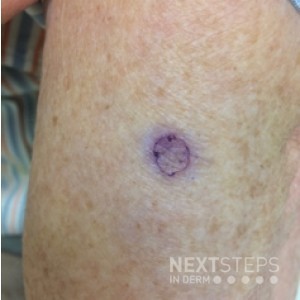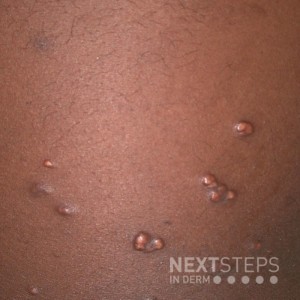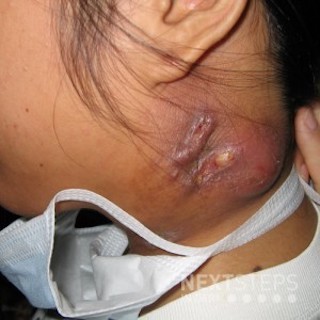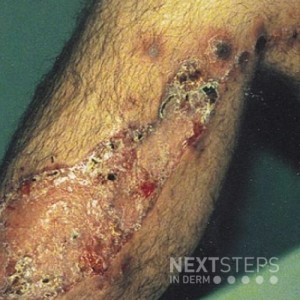Histopathology – Friday Pop Quiz 6/21
 What is the best description of the histopathology expected for the border of the lesion seen here?
A. Regular elongated rete ridges with superficial small vessels
B. Epidermal spongiosis with atypical lymphocytes spreading into the epidermis
C. Perivascular lymphocytic infiltrate with prominent eosinophils
D. Hyperplasia of the superficial epidermis
E. Parakeratosis in a column …
What is the best description of the histopathology expected for the border of the lesion seen here?
A. Regular elongated rete ridges with superficial small vessels
B. Epidermal spongiosis with atypical lymphocytes spreading into the epidermis
C. Perivascular lymphocytic infiltrate with prominent eosinophils
D. Hyperplasia of the superficial epidermis
E. Parakeratosis in a column …
 What is the best description of the histopathology expected for the border of the lesion seen here?
A. Regular elongated rete ridges with superficial small vessels
B. Epidermal spongiosis with atypical lymphocytes spreading into the epidermis
C. Perivascular lymphocytic infiltrate with prominent eosinophils
D. Hyperplasia of the superficial epidermis
E. Parakeratosis in a column …
What is the best description of the histopathology expected for the border of the lesion seen here?
A. Regular elongated rete ridges with superficial small vessels
B. Epidermal spongiosis with atypical lymphocytes spreading into the epidermis
C. Perivascular lymphocytic infiltrate with prominent eosinophils
D. Hyperplasia of the superficial epidermis
E. Parakeratosis in a column … 

 The patient demonstrated with these cutaneous findings would most likely also have which of the following?
A. LDL receptor deficiency
B. Decreased chylomicrons
C. Elevated triglycerides
D. Decreased LDL
E. Decreased triglycerides
To find out the correct answer and read the explanation, click here.
Brought to you by our Brand Partner
…
The patient demonstrated with these cutaneous findings would most likely also have which of the following?
A. LDL receptor deficiency
B. Decreased chylomicrons
C. Elevated triglycerides
D. Decreased LDL
E. Decreased triglycerides
To find out the correct answer and read the explanation, click here.
Brought to you by our Brand Partner
…  Scrofuloderma is most commonly associated with an underlying infection of what organ system?
A. Lymph nodes
B. Spine
C. Lungs
D. Gastrointestinal tract
E. No underlying systemic disease
To find out the correct answer and read the explanation, click here.
Brought to you by our Brand Partner
…
Scrofuloderma is most commonly associated with an underlying infection of what organ system?
A. Lymph nodes
B. Spine
C. Lungs
D. Gastrointestinal tract
E. No underlying systemic disease
To find out the correct answer and read the explanation, click here.
Brought to you by our Brand Partner
…  Which subtype of the human papilloma virus is most likely to have caused this infection?
A. HPV, type 1
B. HPV, type 2
C. HPV, type 3
D. HPV, type 5
E. HPV, type 6
To find out the correct answer and read the explanation, click here.
Brought to you by our Brand Partner
…
Which subtype of the human papilloma virus is most likely to have caused this infection?
A. HPV, type 1
B. HPV, type 2
C. HPV, type 3
D. HPV, type 5
E. HPV, type 6
To find out the correct answer and read the explanation, click here.
Brought to you by our Brand Partner
…  This patient acquired an infection with a microorganism that was most likely inoculated into the skin from contact with:
A. Dead Fish
B. Kittens
C. Jacuzzi tubs
D. Fresh water lakes
E. Rose thorns
To find out the correct answer and read the explanation, click here.
Brought to you by our Brand Partner
…
This patient acquired an infection with a microorganism that was most likely inoculated into the skin from contact with:
A. Dead Fish
B. Kittens
C. Jacuzzi tubs
D. Fresh water lakes
E. Rose thorns
To find out the correct answer and read the explanation, click here.
Brought to you by our Brand Partner
…